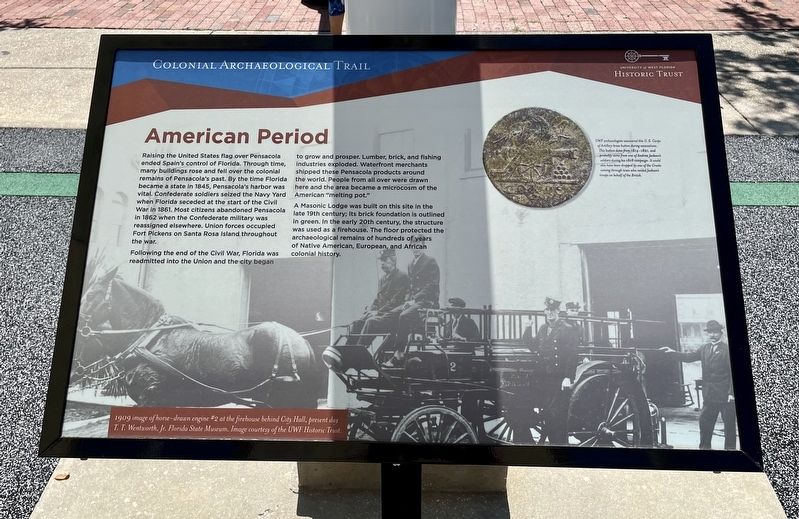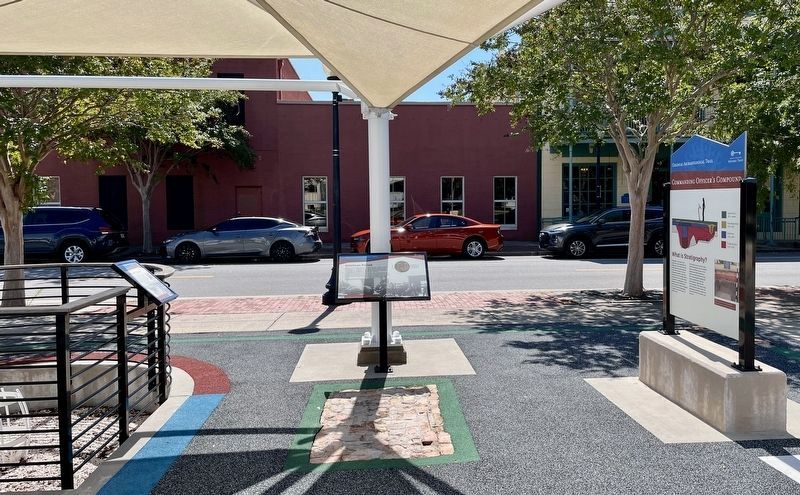Pensacola in Escambia County, Florida — The American South (South Atlantic)
American Period
— Colonial Archaeological Trail —
Following the end of the Civil War, Florida was readmitted into the Union and the city began to grow and prosper. Lumber, brick, and fishing industries exploded. Waterfront merchants shipped these Pensacola products around the world. People from all over were drawn here and the area became a microcosm of the American "melting pot."
A Masonic Lodge was built on this site in the late 19th century; its brick foundation is outlined in green. In the early 20th century, the structure was used as a firehouse. The floor protected the archaeological remains of hundreds of years of Native American, European, and African colonial history.
1909 image of horse-drawn engine #2 at the firehouse behind City Hall, present day T. T. Wentworth, Jr. Florida State Museum. Image courtesy of the UWF Historic Trust.
UWF archaeologists uncovered this U.S. Corps of Artillery brass button during excavations. This button dates from 1814-1821, and probably came from one of Andrea Jackson's soldiers during his 1818 campaign. It could also have been dropped by one of the Creels coming through town who raided Jackson's troops on behalf of the British.
Erected by University of West Florida Historic Trust.
Topics. This historical marker is listed in these topic lists: Anthropology & Archaeology • Colonial Era. A significant historical year for this entry is 1845.
Location. 30° 24.516′ N, 87° 12.761′ W. Marker is in Pensacola, Florida, in Escambia County. Marker is on Zaragoza Street east of South Jefferson Street, on the left when traveling east. Located in Museum Plaza behind the Pensacola Museum of History. Touch for map. Marker is in this post office area: Pensacola FL 32502, United States of America. Touch for directions.
Other nearby markers. At least 8 other markers are within walking distance of this marker. Wells and Cellars (here, next to this marker); Commanding Officer's Compound (here, next to this marker); Archaeology in Pensacola (here, next to this marker); First Spanish Period (here, next to this marker); Colonial Cooking (here, next to this marker); Second Spanish Period (a few steps from this marker); British Period (a few steps from this marker); Stop and Smell the Roses (a few steps from this marker). Touch for a list and map of all markers in Pensacola.
Regarding American Period. The Colonial Archaeological Trail is a collection of outdoor exhibits relating the Spanish, British, and American occupations of Pensacola. This interpretive trail highlights the rich deposits of colonial history and archaeology in the heart of downtown Pensacola.
Credits. This page was last revised on October 10, 2021. It was originally submitted on October 10, 2021, by Mark Hilton of Montgomery, Alabama. This page has been viewed 180 times since then and 11 times this year. Photos: 1, 2. submitted on October 10, 2021, by Mark Hilton of Montgomery, Alabama.

